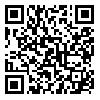Volume 22, Issue 4 (11-2022)
ijdld 2022, 22(4): 245-254 |
Back to browse issues page
1- Department of Psychology, Neyshabur Branch, Islamic Azad University, Neyshabur, Iran
2- Department of Psychology, Neyshabur Branch, Islamic Azad University, Neyshabur, Iran ,mansoury_am@yahoo.com
3- Department of Mathematics, Neyshabur Branch, Islamic Azad University, Neyshabur, Iran
2- Department of Psychology, Neyshabur Branch, Islamic Azad University, Neyshabur, Iran ,
3- Department of Mathematics, Neyshabur Branch, Islamic Azad University, Neyshabur, Iran
Abstract: (1007 Views)
Background: Type 2 diabetes is a chronic and debilitating disease that affects the life expectancy and self-care behaviors of women with this disease. Therefore, the present study aimed to investigate the effectiveness of existential therapy on life expectancy and self-care behaviors of women with type 2 diabetes.
Methods: The research method was applied and quasi-experimental with pre-test and post-test design with control group. The population included all women with type 2 diabetes in Neyshabur, Iran. Among them, 40 people were selected by available sampling method and randomly assigned to experimental and control groups. Participants completed the Hope Scale (HS), and The Summary of Diabetes Self-Care Activities (SDSCA). Multivariate analysis of covariance was used to analyze the data.
Results: The results of analysis of covariance showed that there was a difference between women in the existential therapy group and the control group in life expectancy (F= 10.11, P= 0.0001) and self-care behaviors (F= 176.5, P= 0.003). Existential therapy has increased the mean score of the participants of the experimental group in the variables of life expectancy and self-care behaviors.
Conclusion: The existential therapy can increase life expectancy and self-care behaviors of women with type 2 diabetes by emphasizing freedom, responsibility, meaning and purpose in life, death and relationship with other. Therefore, existential therapy can be used in along with medical treatments.
Methods: The research method was applied and quasi-experimental with pre-test and post-test design with control group. The population included all women with type 2 diabetes in Neyshabur, Iran. Among them, 40 people were selected by available sampling method and randomly assigned to experimental and control groups. Participants completed the Hope Scale (HS), and The Summary of Diabetes Self-Care Activities (SDSCA). Multivariate analysis of covariance was used to analyze the data.
Results: The results of analysis of covariance showed that there was a difference between women in the existential therapy group and the control group in life expectancy (F= 10.11, P= 0.0001) and self-care behaviors (F= 176.5, P= 0.003). Existential therapy has increased the mean score of the participants of the experimental group in the variables of life expectancy and self-care behaviors.
Conclusion: The existential therapy can increase life expectancy and self-care behaviors of women with type 2 diabetes by emphasizing freedom, responsibility, meaning and purpose in life, death and relationship with other. Therefore, existential therapy can be used in along with medical treatments.
Type of Study: Research |
Subject:
Special
Received: 2022/08/19 | Accepted: 2022/11/13 | Published: 2022/11/1
Received: 2022/08/19 | Accepted: 2022/11/13 | Published: 2022/11/1
| Rights and permissions | |
 |
This work is licensed under a Creative Commons Attribution-NonCommercial 4.0 International License. |



